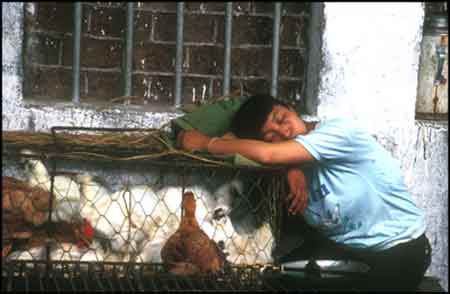
©2005, UrbisMedia
Booo! It’s Halloween again, that time of the year when we like to flirt with the macabre, with and ghosts and goblins, and death. Ah, but it all seems a bit too real to be surreal, too close for kidding around these days. Then again, it might seem rather tame compared to the hurricanes, floods, tsunamis, earthquakes, and now, the specter of Bird Flu, with dire predictions that it might kill as many as 150 million people! That’s scary stuff; seems like you aren’t safe anywhere these days.
I’m a city person. They fascinate me, and they are where I like to be. But while Aristotle said, “We come to cities for safety, and remain there for the good life,” there are circumstances when cities are not safe and the life there can be very short. I learned that before I even became interested in cities when I read Defoe’s A Journal of the Plague Year. I got hooked on bubonic plague, [1] moved on to Hans Zinsser’s Rats, Lice and History: A Chronicle of Disease, Plagues, and Pestilence, and other grisly treatises on deadly viruses and bacilli. But it was Boccacio’s Decameron, the cycle of stories about Florentines escaping their plague-ridden city in the 14th Century to engage in fun and games in the countryside, that brought it to my attention that the densities of cities are not a good environment for avoiding highly communicable virulent diseases.
Richard Preston, author of The Demon in the Freezer, the non-fiction bio-thriller about smallpox, writes that epidemiologists have figured out that smallpox needs densities of about “two hundred thousand people living within fourteen days travel of one another, or the [smallpox] virus can’t keep its life cycle going, and it dies out.” [2] That level of density was first achieved about seven thousand years ago with city-centered settled agricultural areas. Preston calls smallpox, which is a very virulent and very nasty disease, the “first urban virus.” What’s really unnerving for epidemiologists is that today, with air travel, there’s just about no place on earth that isn’t fourteen hours from anyplace else. Add to that that an airliner, with its internal air re-circulation, is an almost ideal vector for airborne infectives. We shouldn’t think homeland security is going to be much help; while they’re scanning your shoes or your laptop for explosives they don’t have an instrument that takes a swab of your seatmate’s hanky and then slap him in quarantine.
So, can you get a little paranoid about these things? Yes. Because unless you walk around with a microscope you are going to have a difficult time determining whether you are even in the presence of microbe or spore of mass destruction. Forget about those aliens who are allegedly arriving from outer galaxies with perverse curiosity about our genitalia. These micro-aliens from our own planet (unless you subscribe to the notion that they arrived on asteroids) want us to be their hosts, invited or not.
But if you are thinking of decamping form your urban habitat for the safer countryside you need to take a few other things into consideration. The countryside is where most of these miniature monsters hail from. The culprits might well be those old friends of ours, domesticated animals. Intelligent design (see how I slipped that in there) might have made it OK for us to eat all critters great and small, but not sleep with them. No, I’m not referring to bestiality here, just something as simple as keeping warm in winter. Think of the crèche scene at Xmas. Those cows and sheep were there to keep baby Jesus warm. Large animals, cows, sheep, and pigs, give off a good bit of heat, so having them in the parlor and bedroom was preferable to freezing. In a lot of countries, there are still very cozy relationships between people and animals. But animals have their own little microbes and bacilli and these sometimes make the jump to human hosts (cowpox, swine flu, syphilis, etc.).
Small wonder, then, that countries with a lot of population in agriculture, particularly poor populations, are the Petrie dishes for diseases that jump hosts. That’s why so many influenzas seem to have Asian names on them. China in particular, with three-quarters of its 1.3 billion people being farmers and herders is the reason that two medical authorities could write “Throughout history epidemics had generally run from east to west.” [3] If personal empirics fit the trend then breathing is believing. I hadn’t had flu for a good decade before a little consulting gig in Guangzhou in 2002. Formerly, Canton, this huge city is the center of Guandong, the province that is suspected to have been the epicenter of the SARS scare that broke out a few months later. I didn’t have SARS, but I did have raging flu that I took back with me to Hong Kong and three days later was coughing it up on a flight back to California. It’s no fun being a vector. [4]
So far the only people dying of H5N1 “bird flu” are people who have had direct contact with infected chicken, ducks, and geese. This is the same circumstance of bubonic plague. But the great fear is that viruses can mutate into versions that are communicated by sputum, infected sores, or through the air; bubonic killed a lot of people, but it was much more virulent when it mutated into pneumonic. If there is a bird flu mutation there is not only the prospect that infected persons might spread the disease by getting on airliners and flying to cities all over the world, but migrating birds themselves might serve to spread the virus to the southern hemisphere.
So far epidemiologists are trying to raise public consciousness and alert governments to be prepared with vaccine countermeasures. We should get past this Halloween safely, but there could come a Halloween when a really cool costume would be a bio-hazard suit.

Chinese woman naps with her chickens. © 1991 UrbisMedia
Booo! It isn’t so scary anymore. Flooo! That’s enough to scare you right out of town!
___________________________________
©2005, James A. Clapp (UrbisMedia Ltd. Pub. 10.29.2005)
[1] I’m still hooked, see DCJournal, No. 18.1
[2] Page 66. Preston also wrote the bio-thriller, The Hot Zone, (1995) about the Ebola virus.
[3] Geoffrey Marks and William K. Beatty, Epidemics, (1976), P. 273
[4] Fortunately, I was in a less crowded business class and had no seatmate. But even keeping my head wrapped in a napkin was not enough to assuage the middle-aged Chinese guy in the seat in front of me, who turned around at one point and whined, “I am going to be very angry with you if my trip is spoiled by your coughing.” Now, why couldn’t we have been in an alley someplace instead of an airliner?
